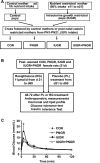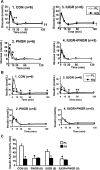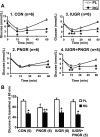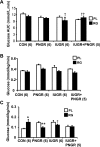Early exposure of the pregestational intrauterine and postnatal growth-restricted female offspring to a peroxisome proliferator-activated receptor-{gamma} agonist
- PMID: 20009032
- PMCID: PMC2838528
- DOI: 10.1152/ajpendo.00361.2009
Early exposure of the pregestational intrauterine and postnatal growth-restricted female offspring to a peroxisome proliferator-activated receptor-{gamma} agonist
Abstract
Prenatal nutrient restriction with intrauterine growth restriction (IUGR) alters basal and glucose-stimulated insulin response and hepatic metabolic adaptation. The effect of early intervention with insulin-sensitizing peroxisome proliferator-activated receptor gamma agonists was examined in the metabolically maladapted F(1) pregestational IUGR offspring with a propensity toward pregnancy-induced gestational diabetes. The effect of rosiglitazone maleate [RG; 11 micromol/day from postnatal day (PN) 21 to PN60] vs. placebo (PL) on metabolic adaptations in 2-mo-old F(1) female rats subjected to prenatal (IUGR), postnatal (PNGR), or pre- and postnatal (IUGR + PNGR) nutrient restriction was investigated compared with control (CON). RG vs. PL had no effect on body weight or plasma glucose concentrations but increased subcutaneous white and brown adipose tissue and plasma cholesterol concentrations in all three experimental groups. Glucose tolerance tests with a 1:1 mixture of [2-(2)H(2)]- and [6,6-(2)H(2)]glucose in RG IUGR vs. PL IUGR revealed glucose tolerance with a lower glucose-stimulated insulin release (GSIR) and suppressed endogenous hepatic glucose production (HGP) with no difference in glucose clearance (GC) and recycling (GR). RG PNGR, although similar to PL CON, was hyperglycemic vs. PL PNGR with reduced GR but no difference in the existent low GSIR, HGP, and GC. RG IUGR + PNGR overall was no different from the PL counterpart. Insulin tolerance tests revealed perturbed recovery to baseline from the exaggerated hypoglycemia in RG vs. the PL groups with the only exception being RG PNGR where further worsening of hypoglycemia over PL PNGR was minimal with full recovery to baseline. These observations support that early intervention with RG suppressed HGP in IUGR vs. PL IUGR, without increasing GSIR similar to that seen in CON. Although RG reversed PNGR to the PL CON metabolic state, no such insulin-sensitizing effect was realized in IUGR + PNGR.
Figures




Similar articles
-
Peroxisome proliferator-activated receptor-gamma agonist improves skeletal muscle insulin signaling in the pregestational intrauterine growth-restricted rat offspring.Am J Physiol Endocrinol Metab. 2009 Aug;297(2):E514-24. doi: 10.1152/ajpendo.00008.2009. Epub 2009 Jun 2. Am J Physiol Endocrinol Metab. 2009. PMID: 19491300 Free PMC article.
-
Early exercise regimen improves insulin sensitivity in the intrauterine growth-restricted adult female rat offspring.Am J Physiol Endocrinol Metab. 2009 Feb;296(2):E272-81. doi: 10.1152/ajpendo.90473.2008. Epub 2008 Nov 11. Am J Physiol Endocrinol Metab. 2009. PMID: 19001551 Free PMC article.
-
Myocardial macronutrient transporter adaptations in the adult pregestational female intrauterine and postnatal growth-restricted offspring.Am J Physiol Endocrinol Metab. 2012 Jun 1;302(11):E1352-62. doi: 10.1152/ajpendo.00539.2011. Epub 2012 Feb 14. Am J Physiol Endocrinol Metab. 2012. PMID: 22338075 Free PMC article.
-
Fetal growth restriction, catch-up growth and the early origins of insulin resistance and visceral obesity.Pediatr Nephrol. 2010 Apr;25(4):669-77. doi: 10.1007/s00467-009-1407-3. Epub 2009 Dec 22. Pediatr Nephrol. 2010. PMID: 20033220 Review.
-
Developmental programming in response to intrauterine growth restriction impairs myoblast function and skeletal muscle metabolism.J Pregnancy. 2012;2012:631038. doi: 10.1155/2012/631038. Epub 2012 Jul 31. J Pregnancy. 2012. PMID: 22900186 Free PMC article. Review.
Cited by
-
The fetal origins of the metabolic syndrome: can we intervene?J Pregnancy. 2012;2012:482690. doi: 10.1155/2012/482690. Epub 2012 Sep 17. J Pregnancy. 2012. PMID: 23029616 Free PMC article. Review.
-
Fetal origins of adult disease.Curr Probl Pediatr Adolesc Health Care. 2011 Jul;41(6):158-76. doi: 10.1016/j.cppeds.2011.01.001. Curr Probl Pediatr Adolesc Health Care. 2011. PMID: 21684471 Free PMC article. Review.
-
Retinoic acid rescues alveolar hypoplasia in the calorie-restricted developing rat lung.Am J Respir Cell Mol Biol. 2013 Feb;48(2):179-87. doi: 10.1165/rcmb.2012-0229OC. Epub 2012 Oct 18. Am J Respir Cell Mol Biol. 2013. PMID: 23087051 Free PMC article.
-
The Placental Transcriptome in Late Gestational Hypoxia Resulting in Murine Intrauterine Growth Restriction Parallels Increased Risk of Adult Cardiometabolic Disease.Sci Rep. 2019 Feb 4;9(1):1243. doi: 10.1038/s41598-018-37627-y. Sci Rep. 2019. PMID: 30718791 Free PMC article.
-
Intrauterine Growth Restriction: Hungry for an Answer.Physiology (Bethesda). 2016 Mar;31(2):131-46. doi: 10.1152/physiol.00033.2015. Physiology (Bethesda). 2016. PMID: 26889018 Free PMC article. Review.
References
-
- Aaboe K, Krarup T, Madsbad S, Holst JJ. GLP-1: physiological effects and potential therapeutic applications. Diabetes Obes Metab 10: 994–1003, 2008 - PubMed
-
- Barker DJ. Adult consequences of fetal growth restriction. Clin Obstet Gynecol 49: 270–283, 2006 - PubMed
-
- Barker DJ, Osmond C, Forsen TJ, Kajantie E, Eriksson JG. Trajectories of growth among children who have coronary events as adults. N Engl J Med 353: 1802–1809, 2005 - PubMed
-
- Bazaes RA, Mericq V. Premature birth and insulin resistance. N Engl J Med 352: 939–940, 2005 - PubMed
-
- Blondeau B, Avril I, Duchene B, Breant B. Endocrine pancreas development is altered in foetuses from rats previously showing intra-uterine growth retardation in response to malnutrition. Diabetologia 45: 394–401, 2002 - PubMed
Publication types
MeSH terms
Substances
Grants and funding
LinkOut - more resources
Full Text Sources
Other Literature Sources
Medical
Miscellaneous

